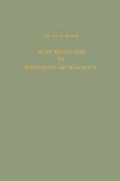Abstract
Few spectacles on the stage of history, played out many centuries ago or in a nearer past, are so fascinating and instructive to an onlooker of our times as the interplay of two peoples differing in origin and level of civilisation. The spectator observes how the politically strongest, moved by the necessity of expansion, by internal pressure, or by some other cause, invades the territory of the less powerful one and by bringing it under its domination calls into being some form of colonial relationship. No less interesting is it then to observe in what way the culture of the conquered people reacts to this foreign rule. Is it weakened, pushed back and annihilated little by little, just as, for instance, the pre-columbian civilisations were eradicated under the dominion of the Spanish conquistadores? Or does the culture of the invaders prove the weaker in the long run, being absorbed by the deeply rooted culture of the subject people, as for instance the tribes which successively invaded the Chinese empire in the course of history were absorbed in the great autochthonous mass and finally disappeared without leaving a trace?
Access this chapter
Tax calculation will be finalised at checkout
Purchases are for personal use only
Preview
Unable to display preview. Download preview PDF.
References
On this relation and the problems raised by it see: N. J. Krom, Hindoe-Javaansche Geschiedenis 2, 1931, p. 90 and passim ; Het oude Java en zijn kunst, 1943, Ch. II; B. Schrieke, Djåwå, III, 1923, p. 198; C. C. Berg, Hoofdlijnen der Javaansche litteratuurgeschiedenis. 1929, p. 12; H. Djajadiningrat, Djåwå, IX, 1929, p. 209; W. F. Stutterheim, Indian influences in the lands of the Pacific, p. 4; J. C. van Leur, Eenige beschouwingen betreffende den ouden Asiatischen handel, 1934, Ch. III (= Indonesian trade and society: Essays in Asian social and economic history, 1955) Djåwå, XIX, 1939, p. 286; A. J. Bernet Kempers, De Indische cultuurstroom, 1934; and the present author, Een hypothese omtrent den oorsprong der Hindoe-Javaansche kunst, in Handelingen van het eerste congres voor de Taal-, Land- en Volkenkunde van Java, 1919 (= Rūpam, I, 19) ; TBG, LIX, 1921, p. 498; TBG, LXV, 1925, p. 509; TBG, LXVII, 1927, p. 462; Djåwå, 1933, p. 8. After 1946, the same relation has been discussed by F. H. van Naerssen, Cultuur contact en en sociale conflicten, 1946; De aanvang van het Hindu-indon. acculturatieproces, in Orientalia Neerlandica, 1948, p. 414; Het sociaal aspect van acculturaties in Indon., Zaire (Rev. congolaise), 1948; W. F. Wertheim, Een nieuwe visie op het oude Oosten, De Nieuwe Stem, 1948, p. 583 (with slight alterations reprinted in Herrijsend Asië, 1950, p. 17); Naar een renaissance van de Indonesische cultuur, Herrijsend Asië, p. 100; G. Coedès, Les états hindouisés, 1948, ch. II and III ; G. W. Locher, Inleidende beschouwin-gen over de ontmoeting van Oost en West in Indonesië, Indonesië, II, 1949, p. 420; H. G. Quaritch Wales, Culture change in Greater India, JRAS, 1948; The making of Greater India, 1951; Prehistory and religion in South-East Asia, 1957; and the present author, “Local genius” en Oud-Javaansche kunst, MKAW, 1952; Uit de grensgebieden tussen Indische invloedssfeer en oud-inheems volksgeloof op Java, BKI, 110, 1954 [1960].
R. Mookerji, A history of Indian shipping and maritime activity, 1912, p. 40.
Op. cit., p. 12.
J. L. Moens, Çrīvijaya, Yāva en Kaṭtāha. TBG, LXXVII, 1937, p. 317.
HJG, p. 90.
G. W. J. Drewes, in : The effect of western influence on native civilisations in the Malay Archipelago, 1929, p. 126.
Bosch, Rūpam I, passim.
For the two next arguments see especially Van Leur, op. cit., Ch. III.
See especially G. Coedès, Les états hindouisés, Ch. II and III.
Cp. Chavannes, Les inscriptions chinoises de Bodh-Gayā, RHR, 1896, pp. 1–58; Prabodh Chandra Bagchi, Le canon bouddhique en Chine, I, 1927, II, 1938.
This theme was treated by me more circumstantially in “Local genius” en Oud-Javaansche kunst, MKAW, 1952, pp. 12 ff. [1960].
Beal, Si-yu-ki, II, pp. 167–175; Life of Hiuen-tsiang, pp. 105–113; Chavannes, Les religieux éminents qui allèrent chercher la loi dans les pays d’occident, 1894, pp. 84–98; Bosch, Een oorkonde van het Groote Klooster te Nālandā, TBG, LXV, 1925, pp. 527 ff.
N. G. Majumdar, Nālandā copper-plate of Devapāladeva, Monogr. of the Varendra Res. Soc. I, 1926; Bosch, loc. cit.
On this date see J. G. de Casparis, Prasasti Indonesia, II, 1956, p. 297 [1960].
On this sect see: H. W. Schomerus, Der Çaiva-Siddhānta, eine Mystik Indiens, 1912;
J. L. Moens, Tjaṇḍi Mendut, TBG, LIX, 1919–21, pp. 520 ff; R. Goris, Bijdrage tot de kennis der Oud-Javaansche en Balineesche theologie, 1926, p. 103 ff. ; Secten op Bali, Mededeelingen van de Kirtya Liefrinck-van der Tuuk, 1931, p. 37; P. H. Pott, Yoga en Y antra, 1946, pp. 119 ff.
An exception to the general rule that brahmins do not travel by sea for fear of being polluted by it, is to be found in the Dharmaśāstra of Baudhāyana (I, i, ii, 4) where this very mode of travelling is cited among the customs of the brahmins of the north (Coedès, Les états hindouisés, p. 61) [1960].
Chavannes, Les religieux éminents, p. XV.
Rights and permissions
Copyright information
© 1961 Springer Science+Business Media Dordrecht
About this chapter
Cite this chapter
Bosch, F.D.K. (1961). The Problem of the Hindu Colonisation of Indonesia. In: Selected Studies in Indonesian Archaeology. Koninklijk Instituut voor Taal-, Land- en Volkenkunde. Springer, Dordrecht. https://doi.org/10.1007/978-94-017-6006-5_1
Download citation
DOI: https://doi.org/10.1007/978-94-017-6006-5_1
Publisher Name: Springer, Dordrecht
Print ISBN: 978-94-017-5691-4
Online ISBN: 978-94-017-6006-5
eBook Packages: Springer Book Archive

